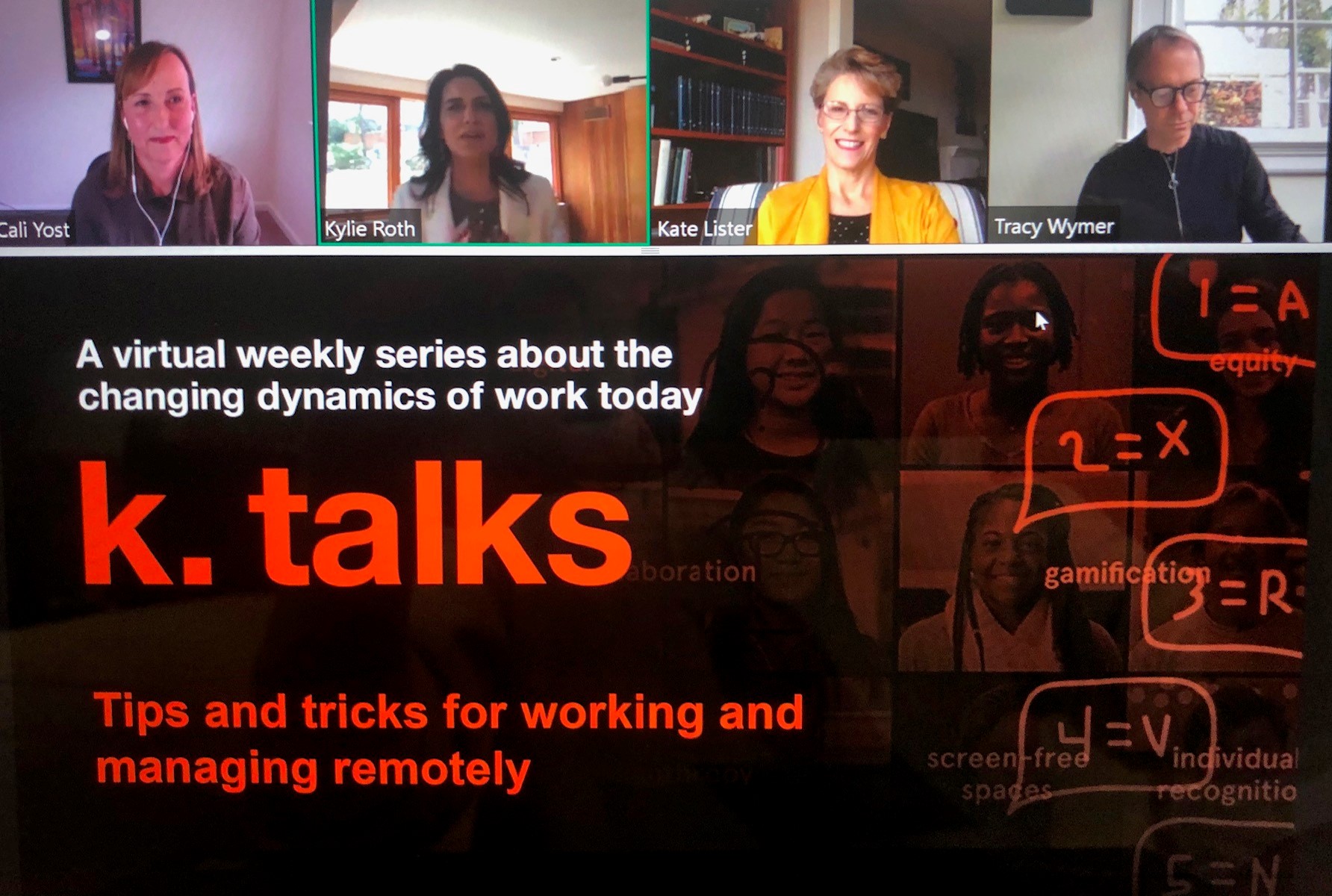- While COVID-19 has disrupted life and business as we know it, thrusting workers around the globe into work from home, it won’t last forever, and it provides some valuable lessons that can be leveraged for the long run.
- During the next 12 to 18 months, organizations will be dialing up and down to flexibility as they figure out what type of remote policy works best for the company and employees.
- Panelists foresee a long-term effect on attitudes of managers, employees and the investment community relative to the benefit of reducing commutes and corporate real estate, including significant savings.
While COVID-19 has disrupted life and business as we know it, thrusting workers around the globe into work from home, it won’t last forever, and it provides some valuable lessons that can be leveraged for the long run.
Speaking at k. talks, a live webcast presented by Knoll, leading workplace experts Cali Yost, Kate Lister and Tracy Wymer shared tips on surviving the current crisis, what it could mean in the larger context and what we can learn from the largest remote work experience ever.

The keys come down to being flexible, forgiving, and not forgetting our humanism.
What is certainly a challenge — the way people work has fundamentally transformed essentially overnight in the midst of an unprecedented crisis — is also a rare opportunity to test and refine new strategies that can be of great benefit to organizations and employees.
With workers at all levels forced to work from home, organizations can gain real-time insights into what makes a successful remote policy and how to best connect and support distributed team members.
It is also a powerful way for managers, particularly those who have been reluctant to consider flexible work strategies, to learn best practices as they experience remote work themselves.
Panelists acknowledged that the COVID-19 situation has created a far-from-normal scenario in which workers are forced to balance their work with the challenges of sheltering in place and home and personal responsibilities and, for many, distractions from young children, pets, roommates or extended family underfoot.
Among other thoughts and outlooks for remote work and a workplace in transition were:
- Flexibility is not a program or a policy. It’s a culture and a way of working. Like it or not the COVID-19 provides a forum to test and learn from. “For the first-time, organizations are seeing what a powerful strategy flexibility in the way work is done can be,” said Cali Williams Yost, CEO and Founder of Flex Strategy Group, as they experience first-hand how flexibility affords maintaining some degree of operating continuity while keeping people safe in the face of a global pandemic.
“What we’re seeing right now is an involuntary rapid culture shift experiment on the most global scale, which I think we will all learn a great deal from if we allow ourselves to do that,” Yost said.
Yost shared some guidelines for success from her experience introducing remote work programs. First is shared leadership. “We tend to think of flexibility as something managers are responsible for, but actually in a flexible work culture, individuals, teams and managers all play a role, she explained.
“I don’t think it’s going to be one day we flip the switch and go back to the way things were.”
Cali Yost
It’s also important to learn from the experience, Yost explained. “At some point you’re going to move past this crisis mode. You’re going to want to build on what you’ve learned and what you’ve already done, and just take it all to the next level in an organized intentional way.”
Yost believes long-term changes will come by way of continued iterations. “For the next 12 to 18 months I believe it’s going to be this kind of dialing up and down to flexibility. I don’t think it’s going to be one day we flip the switch and go back to the way things were. We’re going to have to recalibrate as the environment requires. So, you want to get in the habit of revisiting and revising as you go,” she advised.
Yost also reassured leaders they need not fear that creating a culture of flexibility would open floodgates of people deciding never to come into the office.
“When you open it up to people to determine how, when and where they would work best, the truth of the matter is we find on average people really only want to work remotely one or two days a week,” she said. So, Yost predicted that while remote working rates will likely accelerate, it would not be a universal switch going forward as health concerns are addressed. “I definitely don’t think it’s going to be everybody’s going to be remote all the time. I really, really don’t,” she emphasized.
- Work-from-home policies will leapfrog forward 5 to 10 years as a result of COVID-19. Kate Lister, president of Global Workplace Analytics, predicts that within two years, 25 to 30% of the workforce will be working from home regularly for a variety of reasons.
“The genie’s kind of out of the bottle and it’s not going to readily go back in.”
Kate Lister
1. Employees demand it.
“It’s something that we’ve known for years: 80% of employees say they want flexibility. They want to work from home and flex time is as important as flex space,” Lister notes.
And ready or not, COVID-19 has rolled in flexible work at an unprecedented pace and scale.
“The genie’s kind of out of the bottle, and it’s not going to readily go back in.” she said. While she predicted employees will demand more flexibility, the fact that managers themselves have experienced remote work means the fear factor will be reduced and will continue to decline the longer the situation remains.
Lister said trust has historically been the biggest hurdle for managers when it comes to adopting remote work policies. “This may be the opportunity to really get them over that barrier,” she said.
2. Stakeholders expect it.
Pressure will also likely come from the investment community, with shareholders demanding that companies have disaster preparedness plans that include remote work in place.
3. Economics dictate it.
With a downturn likely in the wings, companies will re-examine real estate, travel and offsite meeting expenses. “I think it’s going to focus attention on the money-saving part of remote work,” Lister said. “We estimate it’s about $11,000 per half-time telecommuter per year. It adds up to big numbers.”
4. Environment benefits from it.
Sustainability is a significant upside of remote work, Lister remarked. “One of the reasons people don’t get behind sustainability is because they can’t see it,” she related. “But in two or three- or four-weeks, we’ve had stark changes in greenhouse gasses and pollution. It’s like, wow, we really can make a difference,” she said. Lister foresees a long-term effect on attitudes of managers, employees and the investment community relative to the benefit of reducing commutes and corporate real estate.
- It’s okay to show our human side. This is not the time to be stoic, but rather let our humanistic and empathetic side show, panelists agreed.
“We are all BBC Dad now, and that really does need to be okay.”
Cali Williams Yost
“Distractions in the workplace are something we’ve been grappling with for a long time,” related Tracy Wymer, Vice President, Workplace Strategy at Knoll. “But now that the workplace is our home, we are realizing a great deal of latitude and understanding towards those distractions.
“All of a sudden we’re exposing everyone to our homes, our books, our pets, our children or spouses. And that is okay,” he continued.
“We’ve been jettisoned into a mashup up between work and life where those two worlds have become one. Just accepting distractions as being what they are and part of life that rounds us out as human beings and are part of our daily contribution to our organization.”
Yost agrees. “Yes, you need to limit distractions, but we have to be really okay with kids and dogs and partners potentially disrupting things. We are all BBC Dad now, and that really does need to be okay if it happens.”
Similarly, Lister advocates relaxing the standards since this is the time to be a bit more flexible, noting, “I think that’s one of the benefits of working remotely that we don’t have to dress up. We can be ourselves and I think it makes us more human.”
“You just have to know we all have lives and it can be many different things.”
Tracy Wymer
“I think the beauty of this is that all the participants – the clients, the customers – they’re understanding that we’re all in this together,” said Wymer. “This is not an isolated incident in any stretch of the imagination. There are high degrees of flexibility and latitude being shared by everyone.”
While virtual backgrounds can hide a home an employee may not want to make public, it’s important to stay focused on the reason we’re getting a look into what previously was kept private, Wymer related. “I think we have to be open to the fact that people’s lives are people’s lives. And they’re not all neat and tidy and sometimes things get a little messy. Just like work itself is messy.”And in the midst of upgrading screens, cameras, microphones and other technology, and equipping home offices with ergonomic chairs and height-adjustable tables, to be our best remote worker self, Wymer reminds us, “Don’t forget to fill the emotional tanks.”
Above all, says Yost, remember, at some point, this will end.
Additional insights from the panel on remote work can be found in a Guide to Remote Work and Managing a Remote Team on the Knoll website.


 Dr. Gleb Tsipursky – The Office Whisperer
Dr. Gleb Tsipursky – The Office Whisperer Nirit Cohen – WorkFutures
Nirit Cohen – WorkFutures Angela Howard – Culture Expert
Angela Howard – Culture Expert Drew Jones – Design & Innovation
Drew Jones – Design & Innovation Jonathan Price – CRE & Flex Expert
Jonathan Price – CRE & Flex Expert













